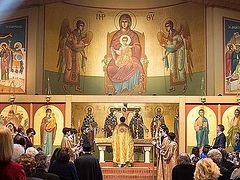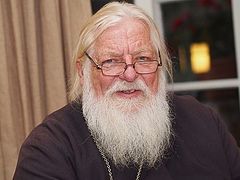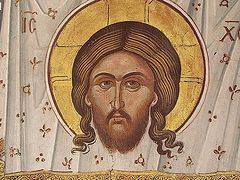 “There is something in these strict images that draws you to them and at the same time repels you. Their fingers folded in a blessing invite us and block our way simultaneously. To respond to their calling we need to abandon the whole life line that in fact dominates in the world.” From Speculation in Colors by Eugene Nikolaevich Trubetskoy.
“There is something in these strict images that draws you to them and at the same time repels you. Their fingers folded in a blessing invite us and block our way simultaneously. To respond to their calling we need to abandon the whole life line that in fact dominates in the world.” From Speculation in Colors by Eugene Nikolaevich Trubetskoy.
When in the post-perestroika years the State began to return churches to the Russian Orthodox Church, we faced the following problem: A church was an architectural monument but the church had no specialists to provide due maintenance for it. That is why the State assigned an architect to each church, and he had broad-reaching powers.
This situation often caused new difficulties when the architect regarded the church rector as an “uncivilized obscurantist”, and the rector regarded the architect as a mere atavism of the Soviet regime who was expected to interfere with the life of the Church at all costs.
And, regrettably, sometimes these assessments from both sides were correct. But I was fortunate: in the Moscow church where I worked the rector was a very God-fearing man.
An architect, a very energetic woman, was assigned to our church too. In regard to “church people” she seemed to have gotten the bit between her teeth, but she was perfect as a specialist. And our rector, I will repeat myself, always strove wholeheartedly to seek God’s will regardless of circumstances. So they found a common language.
I happened to be present at the beginning of this process.
The rector purchased cement in order to plaster the basement. This church was built at the turn of the seventeenth century: though its exterior no longer looked quite traditional for a Russian church, it still retained many features of ancient architecture.
It was a two-storied church with quite a few basements and semi-basements, entrances and exits, intricate niches and recesses, cavities and depressions in its thick walls—for ventilation, acoustics, shelves and for heaven knows what else… This contact with antiquity provoked almost morbid admiration in us, former Soviet Komsomol members.
So our rector purchased cement without consulting our architect. And I witnessed how this woman shouted at the priest I loved dearly:
“What does it mean?! What are you up to?!! You will plaster the third basement with this trash, and the second tier of my iconostasis will be covered in mold!” she screamed, waving the bill for the cement right before the rector’s nose.
“What audacity! Eternal faultfinding!” I thought.
But the venerable archpriest thought otherwise. He apologized and promised her to be more careful regarding building matters. This most probably made the architect calm down immediately and apologize for the unnecessary risk to which she had exposed the priest’s nose.
At that moment the idea that different things can be so amazingly interrelated first struck my consciousness profoundly. And how much you need to learn from your own experience in order to see at least some of them!
***
We are walking through Great Lent. And its first Sunday is dedicated to the dogma of the veneration of icons. As if it were the most important thing in Great Lent, as if it were the main theme and the first discovery we make after the first week of a very strict fast.
Why? What is the connection between these phenomena?
Let us look at some modern Christian denominations that do not recognize icons, though they call themselves Christians. Neither do they accept fasts, long services, standing during services, bows, or prostrations! Neither do they practice monastic life…
And now let us look back on the history of the Church: In the eighth century A.D., iconoclasts in Constantinople were against fasts, long services, bows, etc… Monks were murdered and drowned in sacks… Isn’t this similarity despite the many centuries and miles apart surprising?
Thus, some of those who identify themselves as Christians do not venerate icons and ultimately do not accept the whole system of ascetic life! Besides, those who have preserved holy images but in a distorted form (for example, in the form of art) will have a distorted idea of ascetic life.
Why so? Because the icon is a manifestation of such dogmas of Christianity that will never be comprehended and accepted by the Christian traditions which have abandoned or distorted the concept of ascetic struggle.
Depicted on icons is Human nature transformed by Christian podvig.
Those who are depicted on them struggled and fought against evil here on earth in the Church militant, won in this warfare and entered the Church triumphant.
It is a very special war, which is not like human wars. Evil is so evident, so clear here… And at the same time it is so familiar—fallen man’s own evil. Therefore, special courage and special self-denial are required.
But this evil stood between them and their sweetest Lord—and they didn’t lay down their arms! And now they look at us from icons, from these windows of the Heavenly Kingdom; and we see whom we are dealing with. We see it with our own eyes.
It is not always clear from decorations whether or not you are dealing with a real war veteran and hero. It is far simpler to recognize a war veteran from the stripes he has been awarded for his wounds. Saints are heroes and victors: highlights and gold assist[1] glow on their faces and robes—flashes of the glory of Divine light. But in case we should think that they have been rewarded without extreme self-sacrifice on their part, we can see the traces of the wounds with which they would mercilessly mortify their old Adam. The new man bears these traces just as soldiers bear the stripes they were awarded for their wounds.
Their figures are oblong and very thin.
Their eyes are those of people who are acquainted with grief (Is. 53:3) like their Lord; the eyes of people who came out of great tribulation (Rev. 7:14).
Their faces are strict and concentrated, their lips are dry, their hands are thin…
Thin, but not weak!
Strict, but not censorious!
Sorrowful, but not aloof.
On the contrary, there is great energy, attention and empathy in them. “Their fingers folded in a blessing both invite us and block our way simultaneously” (Eugene Trubetskoy). They invite, for they wholeheartedly want us to share in their joy of the Heavenly Kingdom. And they block our way, because nothing impure or evil will ever enter it.
And, with this extreme asceticism, emaciation and secret sorrow, a true icon is wonderfully colorful and full of the love of life. It can even be said that joy is the main message heralded by icons to the world.
Such a combination of the greatest sorrow and the highest joy is one of the most complicated enigmas the secular art critic faces. But this wonderful link is partly revealed to us believers from inside. There is no Pascha without Holy Week; likewise, it is impossible to attain the joy of the universal Resurrection without experiencing the Cross of Christ.
[1] In iconography, assist gilding is a method of adding rays made of gold to garments or halos, increasing their radiance and of accentuating the glory of the person represented.



